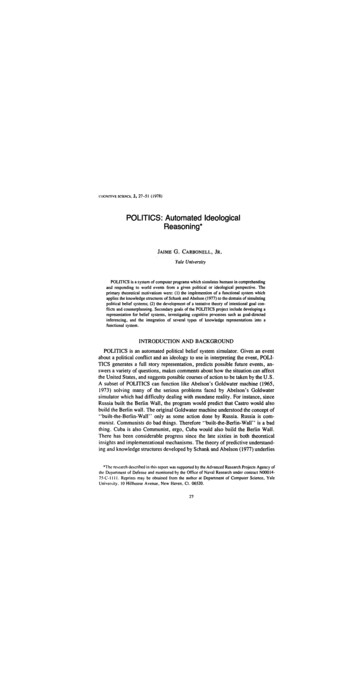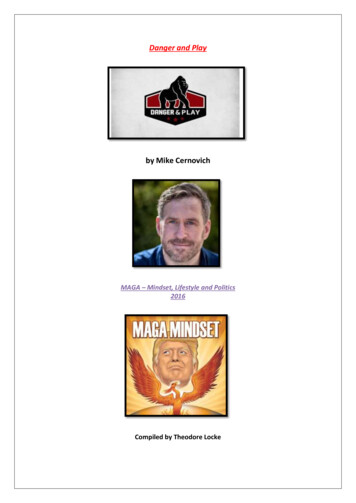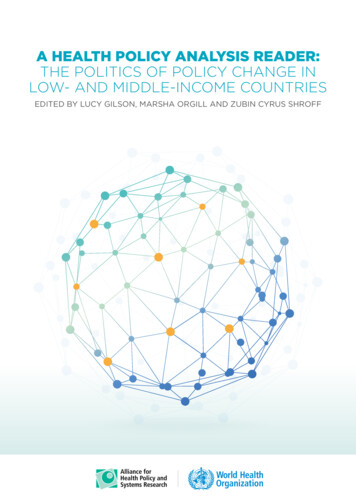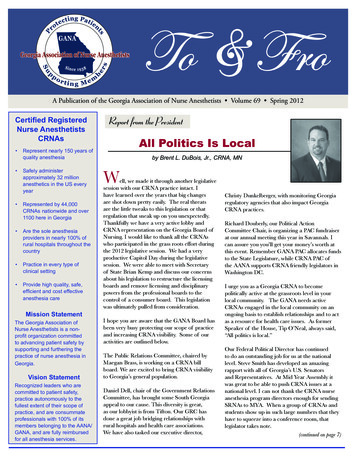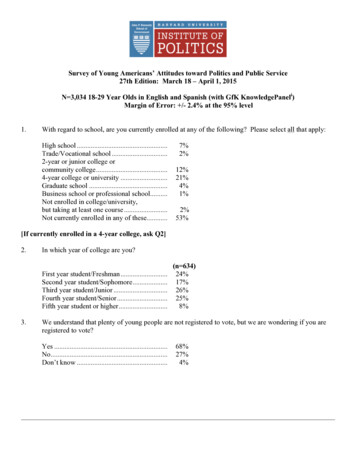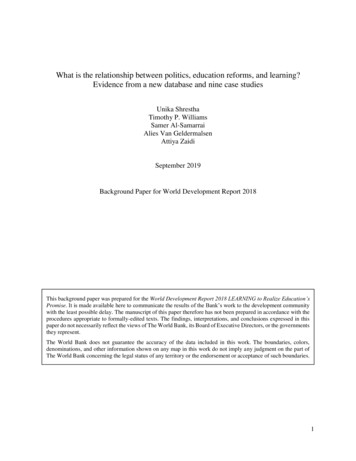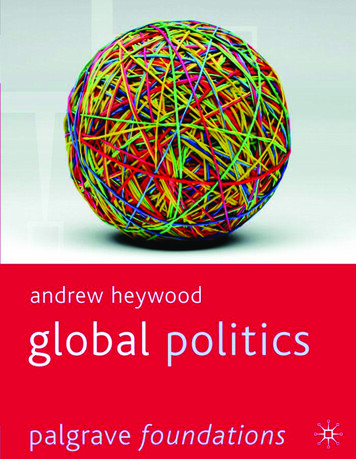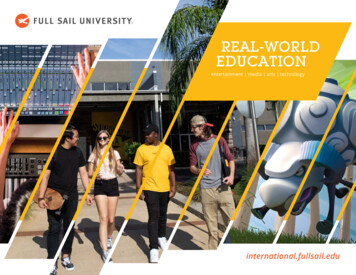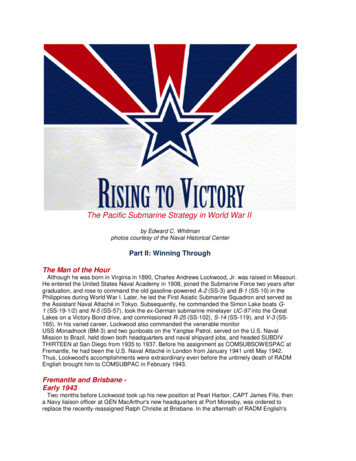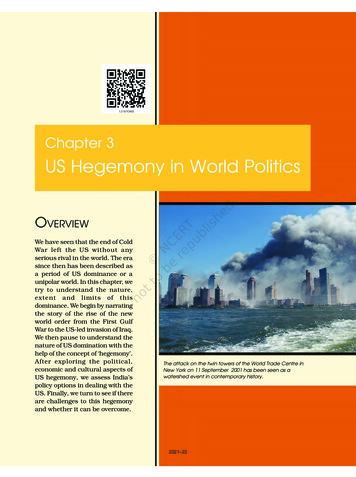
Transcription
Chapter 3US Hegemony in World PoliticsOVERVIEWWe have seen that the end of ColdWar left the US without anyserious rival in the world. The erasince then has been described asa period of US dominance or aunipolar world. In this chapter, wetry to understand the nature,extent and limits of thisdominance. We begin by narratingthe story of the rise of the newworld order from the First GulfWar to the US-led invasion of Iraq.We then pause to understand thenature of US domination with thehelp of the concept of ‘hegemony’.After exploring the political,economic and cultural aspects ofUS hegemony, we assess India’spolicy options in dealing with theUS. Finally, we turn to see if thereare challenges to this hegemonyand whether it can be overcome.The attack on the twin towers of the World Trade Centre inNew York on 11 September 2001 has been seen as awatershed event in contemporary history.2021–22
32Contemporary World PoliticsAYESHA, JABU AND ANDREIAyesha was doing very well in herstudies at a high school in theoutskirts of Baghdad, and wasplanning to study medicine inuniversity. She lost a leg in 2003when a missile slammed into anair raid shelter in which she washiding with her friends. Now sheis learning to walk all over again.She still plans to become a doctor,but only after the foreign armiesleave her country.Jabu is a talented young artistwho lives in Durban, South Africa.His paintings are heavilyinfluenced by traditional tribal artforms. He wants to go to art schooland later open his own studio.However, his father wants him tostudy for an MBA and then jointhe family business. The businessis not doing too well; Jabu’s fatherfeels that with an MBA degree,Jabu will be able to make thefamily business profitable.I’m glad I did not optfor the Sciencesubjects. Or else I toowould have been avictim of UShegemony. Can youthink how and why?Andrei is a young man livingin Perth, Australia. His parents areimmigrants from Russia. Hismother gets very angry every timeAndrei puts on blue jeans to go tochurch. She wants him to lookrespectable in church. Andrei tellshis mother that jeans are “cool”,that they give him the sense offreedom. Andrei’s father remindshis wife how they too used to wearjeans when they were youngstersin Leningrad, and for the samereason that their son now invokes.Andrei has had an argumentwith his mother. Jabu may be2021–22forced to study a subject that hehas no interest in. In contrast,Ayesha has lost her leg and islucky to be alive. How can we evendiscuss their problems in the samebreath? We can, and must, do so.As we shall see in this chapter, allthree have been, in different ways,affected by US hegemony. We willmeet Ayesha, Jabu and Andreiagain. But let us first understandhow US hegemony began and howit operates in the world today.We will follow the popularusage of the word ‘America’ torefer to the United States ofAmerica. But it may be useful toremind ourselves that theexpression America covers the twocontinents of North and SouthAmerica and that the US is onlyone of the countries of theAmerican continent. Thus, the useof the word America solely for theUS is already a sign of the UShegemony that we seek tounderstand in this chapter.BEGINNING OF THE ‘NEWWORLD ORDER’The sudden collapse of the SovietUnion took everyone by surprise.While one of the two superpowersceased to exist, the other remainedwith all its powers intact, evenenhanced. Thus, it would appearthat the US hegemony began in1991 after Soviet powerdisappeared from the internationalscene. This is largely correct, butwe need to keep in mind two ridersto this. First, as we shall see in this
33US Hegemony in World PoliticsThis picture of burned and broken vehicles was taken on the ‘Highway of Death’, a road between Kuwait andBasra, on which the retreating Iraqi army was attacked by American aircraft during the First Gulf War in February1991. Some commentators have suggested that the US forces deliberately bombed this stretch of highway wherefleeing and ‘out of combat’ Iraqi soldiers were stuck in a frenzied traffic jam and that the victims included Kuwaitiprisoners and hostages and Palestinian civilian refugees. Many observers have called it a ‘war crime’ and aviolation of the Geneva Convention.chapter, some aspects of UShegemony did not emerge in 1991but in fact go back to the end ofthe Second World War in 1945.Second, the US did not startbehaving like a hegemonic powerright from 1991; it became clearmuch later that the world was infact living in a period of hegemony.Let us therefore look at thisprocess by which US hegemonygot established more closely.In August 1990, Iraq invadedKuwait, rapidly occupying andsubsequently annexing it. After aseries of diplomatic attempts failedat convincing Iraq to quit itsaggression, the United Nationsmandated the liberation of Kuwaitby force. For the UN, this was adramatic decision after years ofdeadlock during the Cold War. TheUS President George H.W. Bushhailed the emergence of a ‘newworld order’.A massive coalition force of660,000 troops from 34 countriesfought against Iraq and defeatedit in what came to be known asthe First Gulf War. However, the2021–22
34Contemporary World PoliticsUN operation, which was called‘Operation Desert Storm’, wasoverwhelmingly American. AnAmerican general, Nor manSchwarzkopf, led the UN coalitionand nearly 75 per cent of thecoalition forces were from the US.Although the Iraqi President,Saddam Hussein, had promised“the mother of all battles”, theIraqi forces were quickly defeatedand forced to withdraw fromKuwait.Is it true that the US hasnever fought a war onits own land? Doesn’tthat make it easy forAmericans to get intomilitary adventures?The First Gulf War revealed thevast technological gap that hadopened up between the US militarycapability and that of other states.The highly publicised use of socalled ‘smart bombs’ by the US ledsome observers to call this a‘computer war’. Widespreadtelevision coverage also made it a‘video game war’, with viewersaround the world watching thedestruction of Iraqi forces liveon TV in the comfort of theirliving rooms.Incredibly, the US mayactually have made a profit fromthe war. According to manyreports, the US received moremoney from countries likeGer many, Japan and SaudiArabia than it had spent onthe war.THE CLINTON YEARSDespite winning the First GulfWar, George H.W. Bush lost theUS presidential elections of 1992to William Jefferson (Bill) Clinton ofthe Democratic Party, who had2021–22campaigned on domestic ratherthan foreign policy issues. BillClinton won again in 1996 andthus remained the president of theUS for eight years. During theClinton years, it often seemed thatthe US had withdrawn into itsinternal affairs and was not fullyengaged in world politics. Inforeign policy, the Clintongovernment tended to focus on‘soft issues’ like democracypromotion, climate change andworld trade rather than on the‘hard politics’ of military powerand security.Nevertheless, the US onoccasion did show its readiness touse military power even during theClinton years. The most importantepisode occurred in 1999, inresponse to Yugoslavian actionsagainst the predominantlyAlbanian population in theprovince of Kosovo. The air forcesof the NATO countries, led by theUS, bombarded targets aroundYugoslavia for well over twomonths, forcing the downfall ofthe government of SlobodanMilosevic and the stationing of aNATO force in Kosovo.Another significant US militaryaction during the Clinton years wasin response to the bombing of theUS embassies in Nairobi, Kenyaand Dar-es-Salaam, Tanzania in1998. These bombings wereattributed to Al-Qaeda, a terroristorganisation strongly influenced byextremist Islamist ideas. Within afew days of this bombing, PresidentClinton ordered Operation Infinite
35US Hegemony in World PoliticsThis is ridiculous!Does it meanthat Sri Lankacan drop amissile on Paris ifit suspects thatsome of the LTTEmilitants arehiding there?Reach, a series of cruise missilestrikes on Al-Qaeda terrorist targetsin Sudan and Afghanistan. The USdid not bother about the UNsanction or provisions ofinternational law in this regard. Itwas alleged that some of the targetswere civilian facilities unconnectedto terrorism. In retrospect, this wasmerely the beginning.9/11 AND THE ‘GLOBALWAR ON TERROR’On 11 September 2001, nineteenhijackers hailing from a numberof Arab countries took control offour American commercial aircraftshortly after takeoff and flew theminto important buildings in theUS. One airliner each crashed intothe North and South Towers of theWorld Trade Centre in New York.A third aircraft crashed into thePentagon building in Arlington,Virginia, where the US DefenceDepartment is headquartered.The fourth aircraft, presumablybound for the Capitol building ofthe US Congress, came down in afield in Pennsylvania. The attackshave come to be known as “9/11”.(In America the convention is toThis is how The New York Times reported 9/11 in its edition thefollowing morning.write the month first, followed bythe date; hence the short form ‘9/11’ instead of ‘11/9’ as we wouldwrite in India).The attacks killed nearly threethousand persons. In terms of theirshocking effect on Americans, theyhave been compared to the Britishburning of Washington, DC in 1814and the Japanese attack on PearlHarbour in 1941. However, in termsof loss of life, 9/11 was the most2021–22
36Contemporary World Politicssevere attack on US soil since thefounding of the country in 1776.The US forces made arrestsall over the world, often withoutthe knowledge of the governmentof the persons being arrested,transported these personsacross countries and detainedthem in secret prisons. Some ofthemwerebroughttoGuantanamo Bay, a US Navalbase in Cuba, where theprisoners did not enjoy theprotection of international law orthe law of their own country orthat of the US. Even the UNrepresentatives were not allowedto meet these prisoners. Andy Singer, Cagle Cartoons Inc. Andy Singer, Cagle Cartoons Inc.Do they also havepolitical dynasties inthe US? Or was this theonly exception?The US response to 9/11 wasswift and ferocious. Clinton hadbeen succeeded in the USpresidency by George W. Bushof the Republican Party, son ofthe earlier President George H.W. Bush. Unlike Clinton, Bushhad a much harder view of USinterests and of the means bywhich to advance them. As a partof its ‘Global War on Terror’, theUSlaunched‘OperationEnduring Freedom’ against allthose suspected to be behindthis attack, mainly Al-Qaeda andtheTalibanregimeinAfghanistan. The Taliban regimewas easily overthr own, butremnants of the Taliban and Al-Qaeda have remained potent, asis clear from the number ofterrorist attacks launched bythem against Western targetssince.Suppose you are the Secretary of State in the US (their equivalent of our Minister of External Affairs).How would you react in a press conference to these cartoons?2021–22
37US Hegemony in World PoliticsTHE IRAQ INVASIONOn 19 March 2003, the USlaunched its invasion of Iraq underthe codename ‘Operation IraqiFreedom’. More than forty othercountries joined in the US-led‘coalition of the willing’ after the UNrefused to give its mandate to theinvasion. The ostensible purpose ofthe invasion was to prevent Iraqfrom developing weapons of massdestruction (WMD). Since noevidence of WMD has beenunearthed in Iraq, it is speculatedthat the invasion was motivated byother objectives, such as controllingIraqi oilfields and installing a regimefriendly to the US.Although the government ofSaddam Hussein fell swiftly, theUS has not been able to ‘pacify’Iraq. Instead, a full-fledgedinsurgency against US occupationwas ignited in Iraq. While the UShas lost over 3,000 militarypersonnel in the war, Iraqicasualties are very much higher.It is conservatively estimated that50,000 Iraqi civilians have beenkilled since the US-led invasion.It is now widely recognised thatthe US invasion of Iraq was, insome crucial respects, both amilitary and political failure.List the postCold Warconflicts/warsin which theUS played acritical role.[Map of Post-Soviet Countries]Soldier World Map Ares, Cagle Cartoons Inc.WHAT DOES HEGEMONYMEAN?Politics is about power. Just asindividuals want to gain andretain power, groups too want togain and retain power. Weroutinely talk of someonebecoming powerful or someonedoing something for power. In thecase of world politics too,countries and groups of countriesare engaged in constantly tryingto gain and retain power. Thispower is in the form of militarydomination, economic power,political clout and culturalsuperiority.2021–22
38 Angel Boligan, Cagle Cartoons Inc.Contemporary World Politicssystem. This appears to be amisapplication of the idea of ‘pole’derived from physics. It may bemore appropriate to describe aninternational system with only onecentre of power by the term‘hegemony’.We can identify three verydifferent understandings of whathegemony is. Let us examine eachof these meanings of hegemonyand relate them to contemporaryinternational politics.HEGEMONYPOWEREntitled ‘Under US Thumb’, this cartoon captures ourcommonsensical understanding of what hegemony means.What does this cartoon say about the nature of US hegemony?Which part of the world is the cartoonist talking about?Why use suchcomplicated wordslike hegemony? Inmy town they call itdadagiri. Isn’t thatbetter?Therefore, if we wanted tounderstand world politics, it isnecessary that we understand thedistribution of power among thecountries of the world. For instance,during the years of the Cold War(1945-91) power was dividedbetween the two groups ofcountries, and the US and the SovietUnion represented the two ‘camps’or centres of power in internationalpolitics during that period. Thecollapse of the Soviet Union left theworld with only a single power, theUnited States of America.Sometimes, the international systemdominated by a sole superpower, orhyper-power, is called a ‘unipolar’2021–22ASHARDThe roots of the word hegemony liein classical Greek. The word impliesthe leadership or predominance ofone state, and was originally usedto denote the preponderantposition of Athens vis-à-vis theother city-states of ancient Greece.Thus, the first meaning ofhegemony relates to the relations,patterns and balances of militarycapability between states. It is thisnotion of hegemony as militarypreponderance that is especiallygermane to the current positionand role of the US in world politics.Do you remember Ayesha, wholost her leg in an American missileattack? It is hard power hegemonythat has broken Ayesha’s body, ifnot her spirit.The bedrock of contemporaryUS power lies in the overwhelmingsuperiority of its military power.American military dominancetoday is both absolute andrelative. In absolute terms, the US
39US Hegemony in World PoliticsUS COMMAND STRUCTURESource: ote: The representation of boundaries is not necessarily authoritative.today has military capabilities thatcan reach any point on the planetaccurately, lethally and in realtime, thereby crippling theadversary while its own forces aresheltered to the maximum extentpossible from the dangers of war.But even more awesome thanthe absolute capabilities of the USis the fact that no other powertoday can remotely match them.The US today spends more on itsmilitary capability than thenext 12 powers combined.Furthermore, a large chunk of thePentagon’s budget goes intomilitary research and development,or, in other words, technology.Thus, the military dominance ofthe US is not just based on highermilitary spending, but on aqualitative gap, a technologicalchasm that no other power can atpresent conceivably span.Undoubtedly, the US invasionof Iraq reveals several Americanvulnerabilities. The US has notbeen able to force the Iraqi peopleinto submitting to the occupationforces of the US-led coalition. Tofully understand the nature ofAmerican weakness, however, weneed to have a historicalperspective. Imperial powersthrough history have usedmilitary forces to accomplish onlyfour tasks: to conquer, deter,punish and police. As the Iraqinvasion shows, the Americancapacity to conquer is formidable.Similarly, the US capability todeter and to punish is self-evident.Where US military capability hasthus far been shown to have2021–22Most armed forcesin the world dividetheir areas ofoperation intovarious‘commands’which areassigned todifferentcommanders. Thismap depicts theareas ofresponsibility ofthe six Commandsof the US armedforces. It showsthat thecommands of theUS military are notlimited to the areaof the UnitedStates; it extendsto include thewhole world. Whatdoes this map tellus about themilitary power ofthe US?
40Contemporary World PoliticsTop 15 defence budgets 2017 US bnHegemony in thissecond sense isreflected in the roleplayed by the US inprovidingglobalpublic goods. Bypublic goods wemean those goodsthat can be consumedbyonepersonwithout reducing theSource: The Military Balance 2018 (International Institute for Strategic Studies, London)amount of the goodThe US today spends more on its military capability than the next 12 powers combined.available for someoneAs you can see here, most of the other countries that are big military spenders are USelse. Fresh air andfriends and allies. Thus, balancing US power is not a feasible strategy today.roads are examples ofpublic goods. In the context of theserious weaknesses is in policingworld economy, the best examplesan occupied territory.of a global public good are sealanes of communication (SLOCs),HEGEMONY AS STRUCTURALthe sea routes commonly used bymerchant ships. Free trade in anPOWERopen world economy would not bepossible without open SLOCs.The second notion of hegemony isIt is the naval power of thevery different from the first. Itemerges from a particularunderstanding of the worldeconomy. The basic idea is thatan open world economy requiresa hegemon or dominant power tosupport its creation andexistence. The hegemon mustpossess both the ability and thedesire to establish certain normsfor order and must sustain theglobal structure. The hegemonusually does this to its ownadvantage but often to its relativedetriment, as its competitors takeadvantage of the openness of theDollar World2021–22 Ares, Cagle Cartoons Inc.worldeconomywithout paying thecosts of maintaining itsopenness.
41US Hegemony in World PoliticsIt is the naval power of thehegemon that underwrites thelaw of the sea and ensuresfreedom of navigation ininternational waters. Since thedecline of British naval powerafter the Second World War, themulti-oceanic US Navy has playedthis role.Another example of a globalpublic good is the Inter net.Although it is seen today asmaking the virtual world of theWorld Wide Web possible, weshould not forget that the Internetis the direct outcome of a USmilitary research project thatbegan in 1950. Even today, theInternet relies on a global networkof satellites, most of which areowned by the US government.As we know, the US is presentin all parts of the world, in allsectors of the world economy andin all areas of technology. The USshare of the world economyremains an enormous 21 per cent.The US also accounts foralmost 14 per cent of world trade,if intra-European Union trade isincluded in world trade data.There is not a single sector of theworld economy in which anAmerican firm does not feature inthe “top three” list.It is important to rememberthat the economic preponderanceof the US is inseparable from itsstructural power, which is thepower to shape the global economyin a particular way. After all, theBretton Woods system, set up bythe US after the Second World War,still constitutes the basicstructure of the world economy.Thus, we can regard the WorldThe American economy is the largest in the world, but unlike in the sphere of military power,the US faces credible competitors in the world economy. This becomes even clearer if weconsider the world economy in Purchasing Power Parity (PPP) terms as in the graphic on theright. PPP is what a nation’s currency actually buys in goods and services.2021–22How can this countrybe so rich? I see somany poor peoplehere. Most of themare non-White.
42Contemporary World PoliticsBank, International MonetaryFund (IMF) and World TradeOrganisation (WTO) as theproducts of American hegemony.A classic example of thestructural power of the US is theacademic degree called theMaster’s in Business Administration(MBA). The idea that business isa profession that depends uponskills that can be taught in auniversity is uniquely American.The first business school in theworld, the Wharton School at theUniversity of Pennsylvania, wasestablished in 1881. The first MBAcourses were initiated around1900. The first MBA courseoutside the US was establishedonly in 1950. Today, there is nocountry in the world in which theMBA is not a prestigious academicdegree. This takes us back to ourSouth African friend Jabu.Structural hegemony explainswhy Jabu’s father is insisting thathis son gives up painting andstudies for the MBA instead.HEGEMONY AS SOFT POWERIf I had opted for theScience subjectsI would have to sit forthe entrance exams tomedical orengineering college.That would meancompeting with somany others who wishto become doctors orengineers so as to goto the US.It would however be a mistake tosee US hegemony in purely militaryand economic terms withoutconsidering the ideological or thecultural dimension of UShegemony. This third sense ofhegemony is about the capacity to‘manufacture consent’. Here,hegemonyimpliesclassascendancy in the social, politicaland particularly ideologicalspheres. Hegemony arises whenthe dominant class or country can2021–22win the consent of dominatedclasses, by persuading thedominated classes to view theworld in a manner favourable to theascendancy of the dominant class.Adapted to the field of worldpolitics, this notion of hegemonysuggests that a dominant powerdeploys not only military power butalso ideological resources to shapethe behaviour of competing andlesser powers. The behaviour of theweaker countries is influenced inways that favour the interests ofthe most powerful country, inparticular its desire to remain preeminent. Consent, in other words,goes hand-in-hand with, and isoften more effective than, coercion.The predominance of the US inthe world today is based not onlyon its military power and economicprowess, but also on its culturalpresence. Whether we choose torecognise the fact or not, all ideasof the good life and personalsuccess, most of the dreams ofindividuals and societies acrossthe globe, are dreams churned outby practices prevailing intwentieth-century America.America is the most seductive, andin this sense the most powerful,culture on earth. This attribute iscalled ‘soft power’: the ability topersuade rather than coerce. Overtime we get so used to hegemonythat we hardly notice it, any morethan we notice the rivers, birds,and trees around us.You couldn’t have forgottenAndrei and his ‘cool’ pair of bluejeans. When his parents wereyoungsters in the Soviet Union,
43US Hegemony in World Politicsblue jeans were the ultimatesymbol of ‘liberation’ for theirgeneration. Young men andwomen often spent over a year’ssalary to buy blue jeans fromforeign tourists on the blackmarket. Somehow, for an entireSoviet generation blue jeans cameto represent aspirations of the‘good life’ that were not availablein their own country.During the Cold War, the USfound it difficult to score victoriesagainst the Soviet Union in therealm of hard power. It was in thearea of structural power and softpower that the US scored notablevictories. Although the Sovietcentrally-planned economyprovided an alternate model ofinternal economic organisation,the world economy throughout theCold War years remained a worldcapitalist economy. But it was inthe area of soft power that the USwas ultimately triumphant. As theexample of blue jeans in the SovietThat is strange!I never think of theUS when buyingjeans for myself.How can I still bea victim of UShegemony?All these images are from Jakarta inIndonesia. Identify elements of UShegemony in each of thesephotographs. Can you identify similarelements on your way back fromschool to home?2021–22
44Contemporary World PoliticsUnion clearly shows, the US wasable to engineer a generationaldivide in Soviet society on the basisof a cultural product.CONSTRAINTSPOWERONAMERICANHistory tells us that empiresdecline because they decay fromwithin. Similarly, the biggestconstraintstoAmericanhegemony lie within the heart ofhegemony itself. We can identifythree constraints on Americanpower. None of these constraintsseemed to operate in the yearsfollowing 9/11. However, it nowappears that all three of theseconstraints are slowly beginningto operate again.The first constraint is theinstitutional architecture of theAmerican state itself. A system ofdivision of powers between thethree branches of governmentplaces significant brakes upon theunrestrained and immoderateexercise of America’s militarypower by the executive branch.The second constraint onAmerican power is also domesticin nature, and stems from theopen nature of American society.Although the American massmedia may from time to timeimpose or promote a particularperspective on domestic publicopinion in the US, there isnevertheless a deep scepticismregarding the purposes andmethods of government inAmerican political culture. Thisfactor, in the long run, is a hugeconstraint on US military actionoverseas.However, it is the thirdconstraint on the US that isperhaps the most important.There is only one organisation inthe international system thatcould possibly moderate theThese two photographs are from an exhibition on the Human Costs of the Iraq War by the American FriendsService Committee organised at the National Convention of the Democratic Party in 2004. To what extent doprotests like this constrain the US government?2021–22
45US Hegemony in World Politicsexercise of American power today,and that is the North AtlanticTreaty Organisation (NATO). TheUS obviously has an enormousinterest in keeping the alliance ofdemocracies that follow themarket economies alive andtherefore it is possible that itsallies in the NATO will be able tomoderate the exercise of UShegemony.INDIA’S RELATIONSHIP WITHTHE USDuring the Cold War years, Indiafound itself on the opposite sideof the divide from the US. India’sclosest friendship during thoseyears was with the Soviet Union.After the collapse of the SovietUnion, India suddenly found itselffriendless in an increasingly hostileinternational environment. However,these were also the years whenIndia decided to liberalise itseconomy and integrate it with theglobal economy. This policy andIndia’s impressive economicgrowth rates in recent years havemade the country an attractiveeconomic partner for a number ofcountries including the US.It is important that we do notlose sight of the fact that two newfactors have emerged in Indo-USrelations in recent years. Thesefactors relate to the technologicaldimension and the role of theIndian-American diaspora.Indeed, these two factors areinterrelated.following facts:ConsidertheThe US absorbs about 65 percent of India’s total exports inthe software sector.35 per cent of the technicalstaff of Boeing is estimated tobe of Indian origin.300,000 Indians work inSilicon Valley.15 percent of all high-techstart-ups are by IndianAmericans.Like all other countries, Indiatoo has to decide exactly what typeof relationship it wants with the USin this phase of global hegemony.The choices are not exactly easy.Within India, the debate seems tobe around three possible strategies.Those Indian analysts who seeinternational politics largely interms of military power arefearful of the growingcloseness between India andthe US. They would prefer thatIndia maintains its aloofnessfrom Washington and focusesupon increasing its owncomprehensive national power.Other analysts see the growingconvergence of interestsbetween the US and India as ahistoric opportunity for India.They advocate a strategy thatwould allow India to takeadvantage of US hegemonyand the mutual convergencesto establish the best possibleoptions for itself. Opposing theUS, they argue, is a futile2021–22As soon as I say I amfrom India, they askme if I am acomputer engineer.That feels nice.Collect newsclippings andarticles aboutthe recentIndo-US civilnuclear deal.Summarise theposition of thesupporters andopponents ofthe deal.
46Contemporary World PoliticsLOK SABHA DEBATES INDO-USRELATIONSHere are three extracts from the speeches by the PrimeMinister and two opposition leaders during the debatein Lok Sabha on the Indo-US agreement on nuclearenergy. Are these three positions in some way linkedto the three strategies mentioned in the chapter?Dr Manmohan Singh, Congress“Sir, I would respectfully urge this august House torecognise the changed mood of the world towardsIndia. This is not to say that power politics is a thing ofthe past; that there will never be any attempt to twistour arms. We will protect ourselves to ensure againstthe risks that are there. But it would be wrong for usnot to take advantage of the opportunities that arenow on the horizon. I sincerely believe that it is in theinterest of our country to have good relations with allthe major powers. I make no apology that we seekgood relations with the United States. The United Statesis a pre-eminent power.”Shri Basu Deb Acharia, CPI(M)“Since Independence, we have been pursuingindependent foreign policy because of our nationalinterest. What have we seen in case of Iraq and incase of Iran? After the July statement, and when therewas voting in International Atomic Energy Agency, wefound that we sided with the United States of America.We supported the resolution moved by US and P 5.That was not expected before that. When we weretrying to bring gas from Iran via Pakistan which weneed, we supported America’s stand in regard to Iran.There we find that the in
serious rival in the world. The era since then has been described as a period of US dominance or a unipolar world. In this chapter , we try to understand the nature, extent and limits of this dominance. W e begin by narrating the story of the rise of the new world order from the First Gulf

